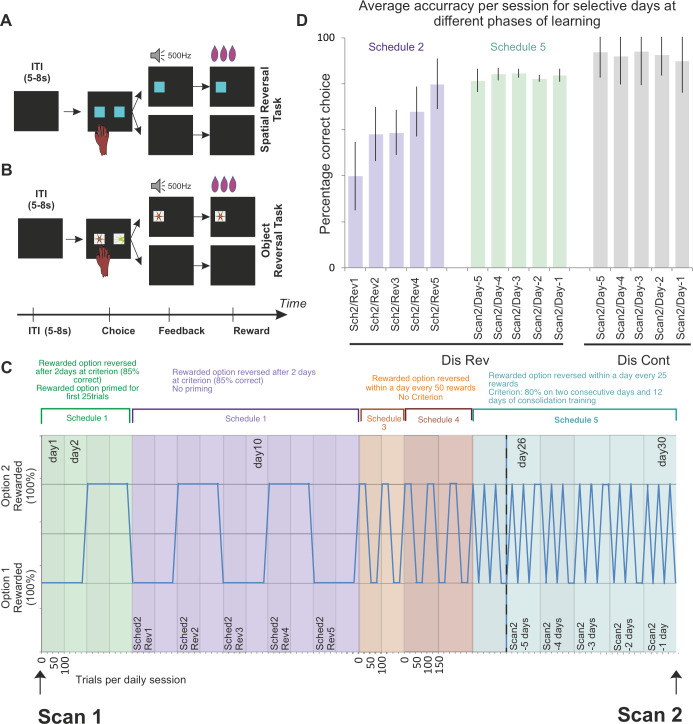Fig 1.
Trial structure in (A) spatial DisRev, (B) object DisRev, and (C) overview of DisRev experience between structural scan 1 and 2 in a longitudinal investigation of the effect of learning on brain structure and function. The schematic illustrates an ideal performer. The minimum number of trials needed by an ideal performer per daily session is illustrated on the abscissa, and reward properties of the two options are plotted on the ordinate. All reversal tasks were deterministic (in any given period, one option was always rewarded when chosen, and the other option was never rewarded when chosen). In the first testing schedules, animals completed 100 trials per day, and one of two simultaneously presented options was designated the rewarded target for the day. In schedule 1, the rewarded choice was primed for 25 trials before introducing, in addition, the unrewarded choice on the opposite side of the screen for an additional 75 trials. The choice–reward contingencies were reversed the day after each animal performed above 85% correct for two consecutive days. Schedule 2 was similar, but now the rewarded choice was not primed. Animals experienced five reversals under schedule 2. With perfect performance, an animal could, therefore, complete this second phase in 10 days. Schedules 3 and 4 introduced a choice–reward association reversal within a given day’s testing session; the reversal occurred once the animal had correctly chosen the target 50 times. The animals completed 2 days of 100 trials and 3 days of 150 trials on schedules 3 and 4, respectively. There was no performance criterion in these phases. As such, schedules 3 and 4 were not goals in themselves but stepping stones toward the more volatile reward environment of schedule 5. In the final schedule, the rewarded targets reversed after 25 correctly performed trials. In total, the animals had to perform 150 correct trials in a day. Their second scan took place once performance exceeded 80% correct for two consecutive days and after 12 subsequent days of consolidation training. (D) Average correct performance over session for the first five sessions they encountered a reversal (schedule 2 sessions; see Fig 1C) and for the last 5 days prior to the second scan (schedule 5 sessions). During schedule 2, monkeys performed at approximately 55% accuracy, but by schedule 5 reversal, they performed at 80% accuracy. Data are available on https://www.jeromesallet.org/data-ofc-reversal-learning and https://doi.org/10.5281/zenodo.3776631. Dis Cont, discrimination control; DisRev, discrimination reversal; ITI, intertrial interval; Rev, reversal; Sch, schedule; Sched, schedule.

